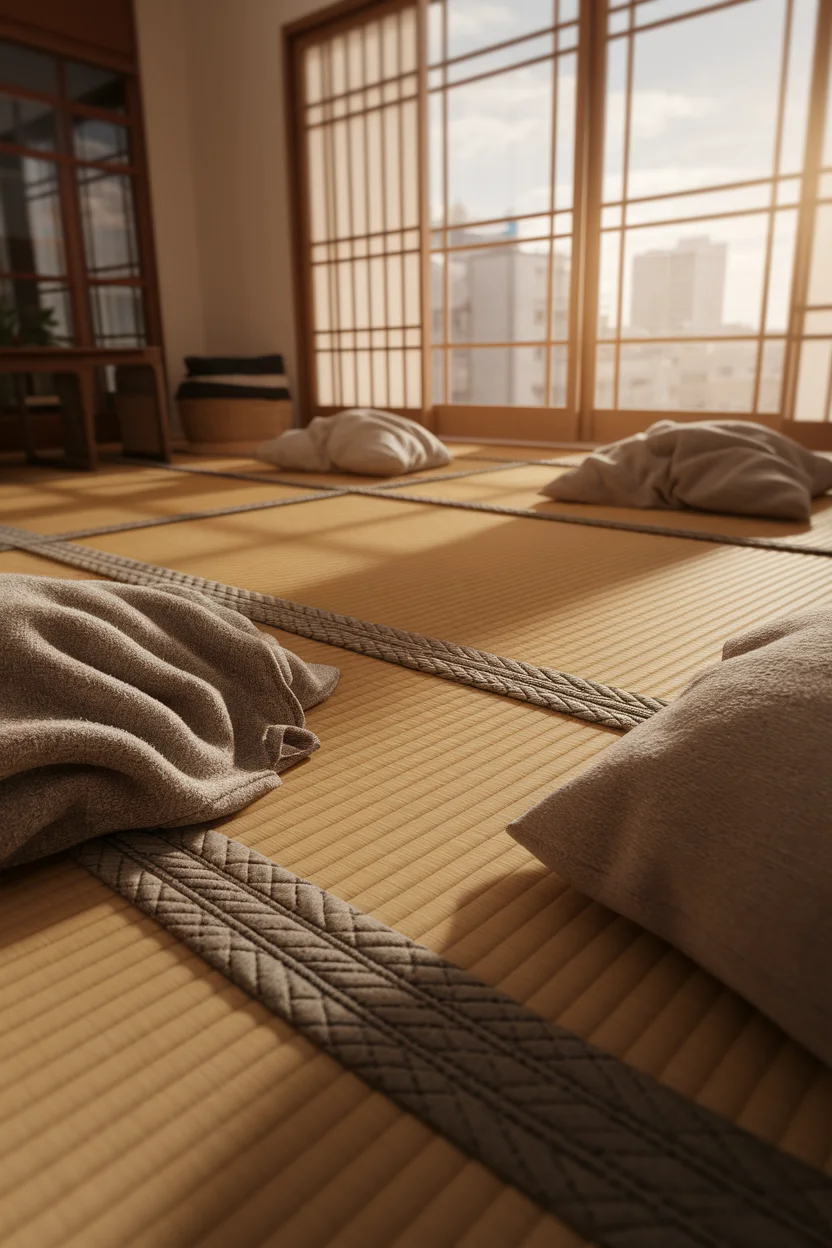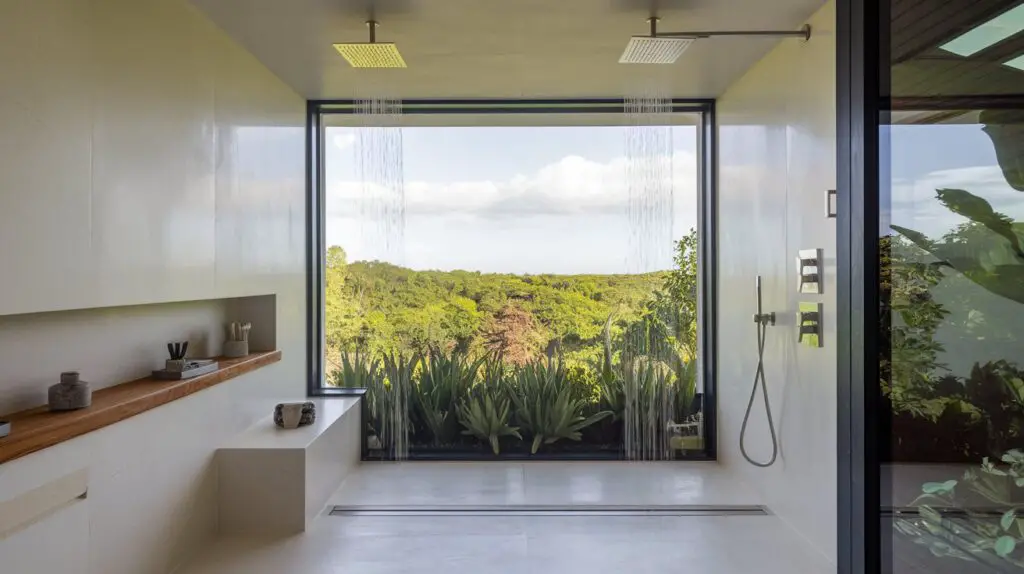Creating a harmonious blend of Japanese minimalism and Scandinavian functionality, Japandi design offers a serene and inviting aesthetic perfect for crafting a natural, cozy space. This stylistic fusion emphasizes simplicity, natural materials, and muted colors, resulting in an environment that exudes warmth and tranquility. By integrating smart Japandi hacks, you can transform your home into a soothing retreat that balances elegance with comfort, all while maintaining a deep connection to the natural world.
Incorporate Natural Textures
Creating a Japandi-inspired space involves blending the minimalist elegance of Japanese design with the cozy comfort of Scandinavian style. One effective way to achieve this balance is by incorporating natural textures into your space. Natural textures can add depth, warmth, and a sense of tranquility, all of which are essential elements of the Japandi style.
How to Achieve It
Use Wooden Elements
:
– Choose light to medium wood finishes for furniture, such as oak, maple, or walnut.
– Consider a wooden coffee table, chairs, or shelving units.
– Opt for slatted wooden dividers or paneling to add architectural interest.
Add Textured Textiles
:
– Introduce natural fibers like linen, cotton, or wool for throws, pillows, and rugs.
– Layer soft, organic cotton or linen throws over sofas or beds for added warmth.
– Use a wool or jute rug to anchor the room and provide comfort underfoot.
Incorporate Living Plants
:
– Add indoor plants such as ferns, snake plants, or peace lilies to bring a touch of nature indoors.
– Use ceramic or stone planters in neutral colors to complement the natural elements.
Choose a Neutral Color Palette
:
– Stick to a soothing color scheme of beiges, creams, soft grays, and muted earth tones.
– Use a gentle contrast of light and dark elements to maintain visual interest without overwhelming the space.
Utilize Natural Light
:
– Maximize natural light by keeping window treatments to a minimum.
– Use sheer curtains or blinds to allow light to filter in while maintaining privacy.
Incorporating these natural textures will help you create a Japandi space that is both inviting and serene, perfect for a cozy and harmonious environment.
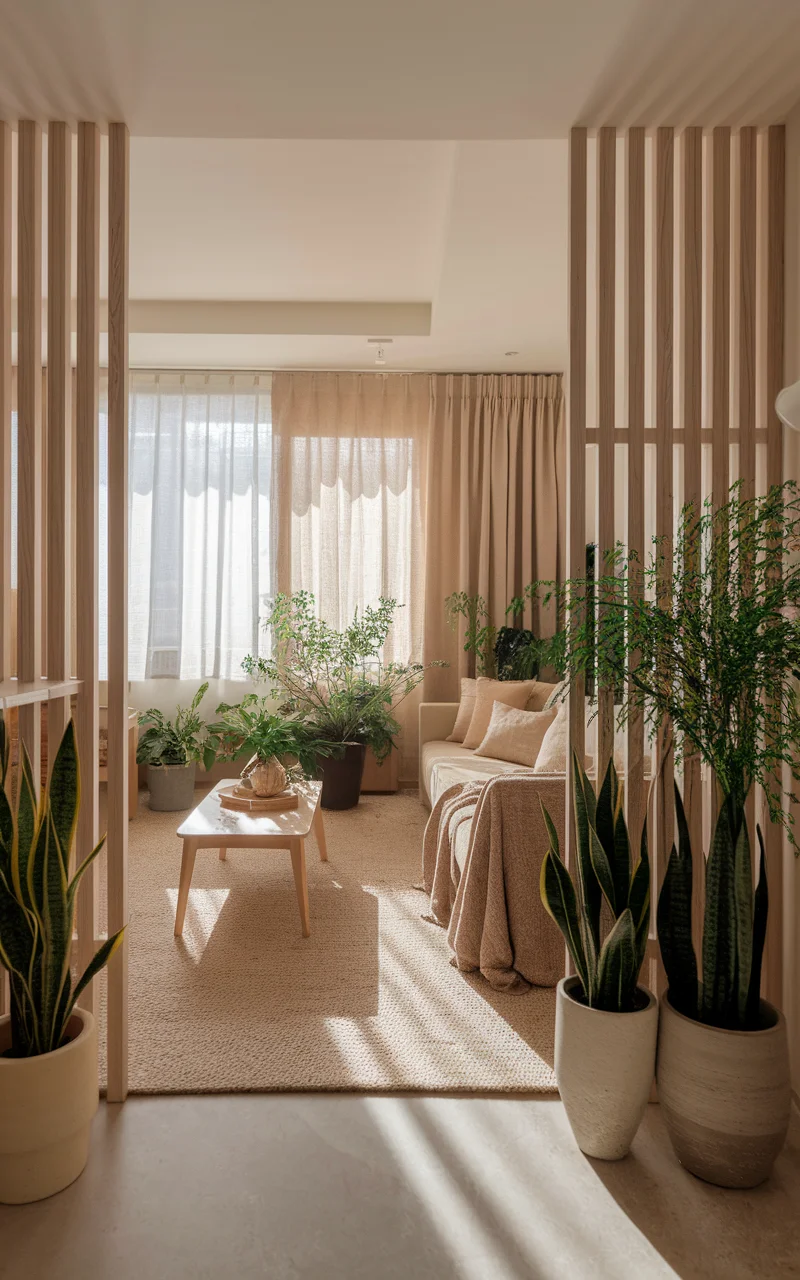
Introduce Layered Lighting
For a truly cozy and inviting Japandi space, consider implementing a layered lighting approach. Japandi design emphasizes simplicity and functionality, and lighting plays a crucial role in setting the mood and enhancing the natural aesthetic. By using a variety of lighting sources, you can create a warm and balanced ambiance that highlights key elements in your space while maintaining its minimalist appeal.
How to Achieve It
Utilize Ambient Lighting
:
– Install ceiling fixtures or recessed lighting that emits a soft, warm glow.
– Opt for fixtures with simple, clean lines that echo the Japandi aesthetic.
– Use dimmer switches to adjust lighting levels according to different times of the day or mood.
Add Task Lighting
:
– Position reading lamps next to seating areas or beds for focused illumination.
– Choose adjustable lamps with natural materials like wood or metal to align with the Japandi style.
– Ensure that task lights are sleek and unobtrusive, complementing the overall design.
Incorporate Accent Lighting
:
– Use floor or table lamps to highlight architectural features or decor items such as artwork or plants.
– Consider lantern-style lamps for a touch of Japanese influence and traditional ambiance.
– Select fixtures with a neutral color palette, such as matte black, white, or natural wood tones.
Embrace Natural Candlelight
:
– Place candles in minimalistic holders on tables or shelves to add warmth and a calming atmosphere.
– Opt for odorless candles in simple glass or ceramic jars to maintain the clean aesthetics of the space.
– Arrange candles in groups of varied heights for visual interest and cozy illumination.
Layered lighting not only enhances the functionality of a room but also plays a vital part in crafting an environment that feels both serene and inviting, staying true to the principles of Japandi design.
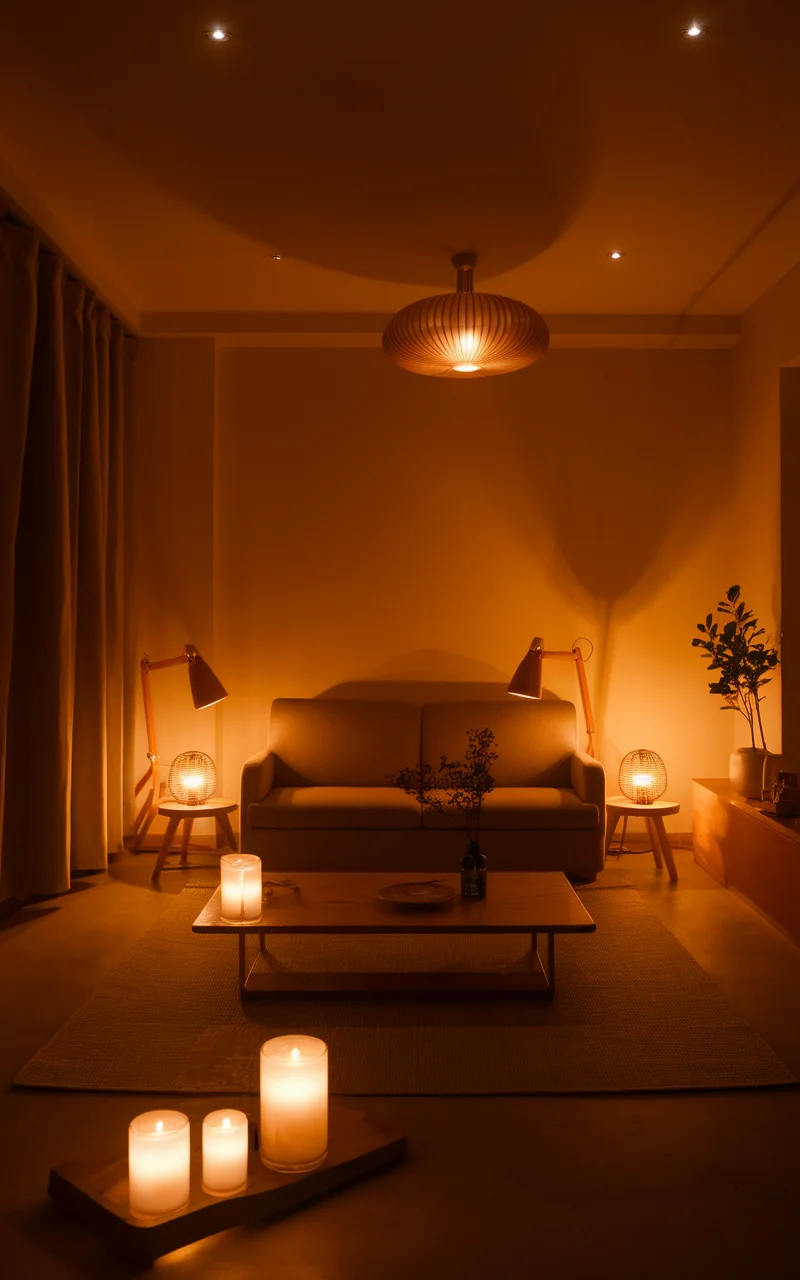
Incorporate Minimalist Artwork
Integrating minimalist artwork into your Japandi-inspired space can significantly enhance its aesthetic appeal while embodying the simplicity and tranquility that the style demands. By selecting the right pieces, you can inject personality into your environment without cluttering it, fostering a serene, artful space that remains harmonious and cozy.
How to Achieve It
Choose Simple, Abstract Pieces
:
– Opt for artworks that feature clean lines and uncomplicated forms.
– Consider pieces in neutral color palettes like black, white, beige, or soft pastels to complement the Japandi color scheme.
Embrace Natural Themes
:
– Select art that depicts elements of nature, such as landscapes, flora, or fauna, to reinforce the connection to the natural world.
– Look for art that utilizes organic materials, like handmade paper or wood-backed canvases.
Create a Focal Point
:
– Use a large piece of minimalist art as a room’s centerpiece to draw the eye and unify the space.
– Ensure the proportions are balanced with the surrounding furniture and decor to maintain harmony.
Experiment with Textures
:
– Consider pieces with varying textures, like mixed media or raised details, to add depth and interest.
– Frame artworks with simple wooden or metal frames that blend with the room???s other elements.
Limit the Number of Pieces
:
– Keep the number of artworks minimal to prevent the space from feeling cluttered or overwhelming.
– Opt for a few carefully chosen pieces that echo the colors and textures found throughout the room.
Incorporating minimalist artwork into your Japandi space not only enhances its aesthetic but also supports the style???s emphasis on simplicity and tranquility, resulting in a soothing and balanced environment.
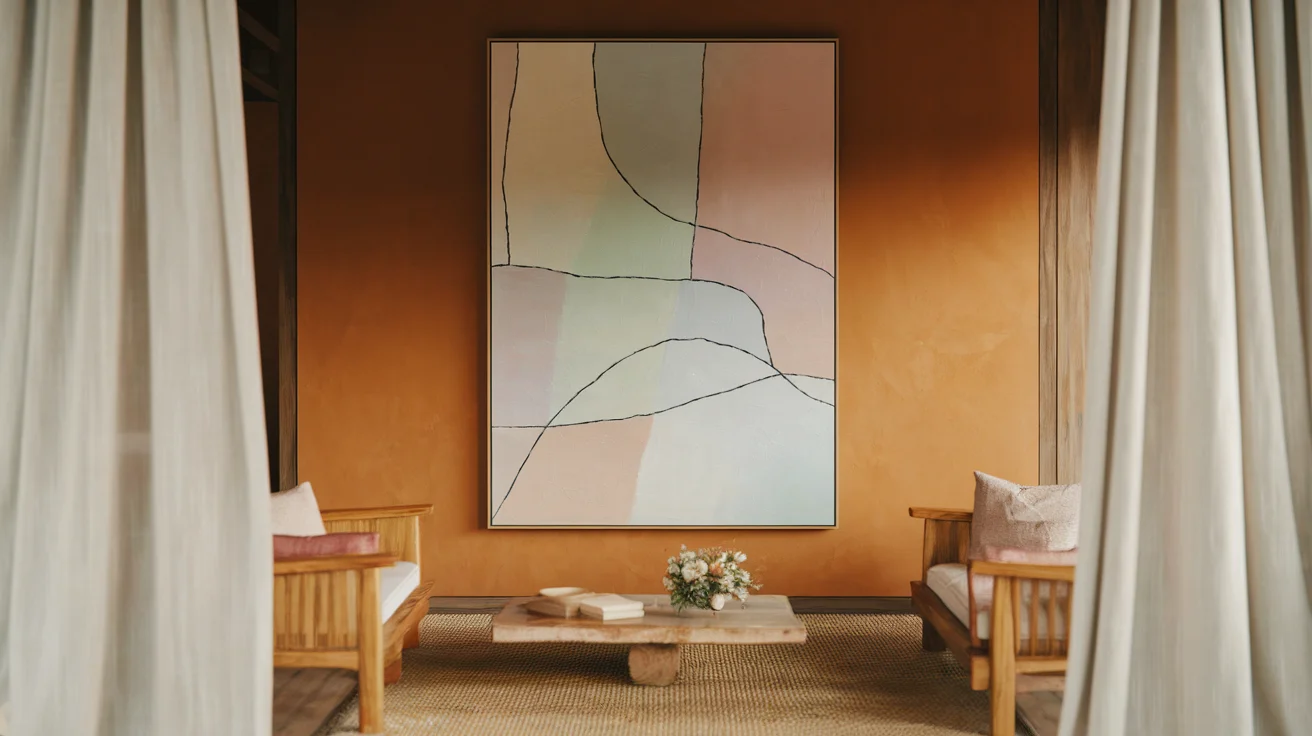
Integrate Sustainable Materials
Embracing sustainable materials in your Japandi-inspired space promotes an eco-friendly lifestyle while enhancing the natural and cozy atmosphere. Japandi style values simplicity and authenticity, which align perfectly with sustainable practices. By choosing materials that are environmentally friendly, you create a space that is not only aesthetically pleasing but also conscious of its impact on the planet.
How to Achieve It
Opt for Reclaimed Wood
:
– Use reclaimed wood for furniture pieces such as tables, shelves, or cabinets to add character and history to your space.
– Ensure that the wood is sourced responsibly and treated with natural finishes to maintain its eco-friendly properties.
Incorporate Bamboo Elements
:
– Choose bamboo furniture or accessories like blinds, baskets, or rugs due to its fast-growing, renewable nature and sturdy properties.
– Opt for bamboo flooring to add natural warmth and durability, perfect for a Japandi aesthetic.
Use Organic Textiles
:
– Look for textiles made from organic cotton, hemp, or linen for bedding, curtains, or upholstery.
– Ensure these textiles are colored with natural dyes to reduce chemical use, maintaining a neutral and earthy palette.
Choose Recycled or Upcycled Decor
:
– Select decor items created from recycled glass, metal, or ceramic to give new life to materials that would otherwise be discarded.
– Consider handmade items that incorporate upcycled materials, ensuring each piece tells a unique story and enhances the room???s charm.
Adopt Zero Waste Practices
:
– Incorporate repurposed jars, bins, or crates for storage solutions that minimize waste.
– Ensure minimal packaging waste by purchasing local products that support sustainable practices.
Integrating sustainable materials aligns with the Japandi approach of simplicity and mindfulness, enhancing your space’s natural and cozy vibe while caring for the planet. This thoughtful choice adds depth to the design???a seamless blend of style and environmental consciousness.
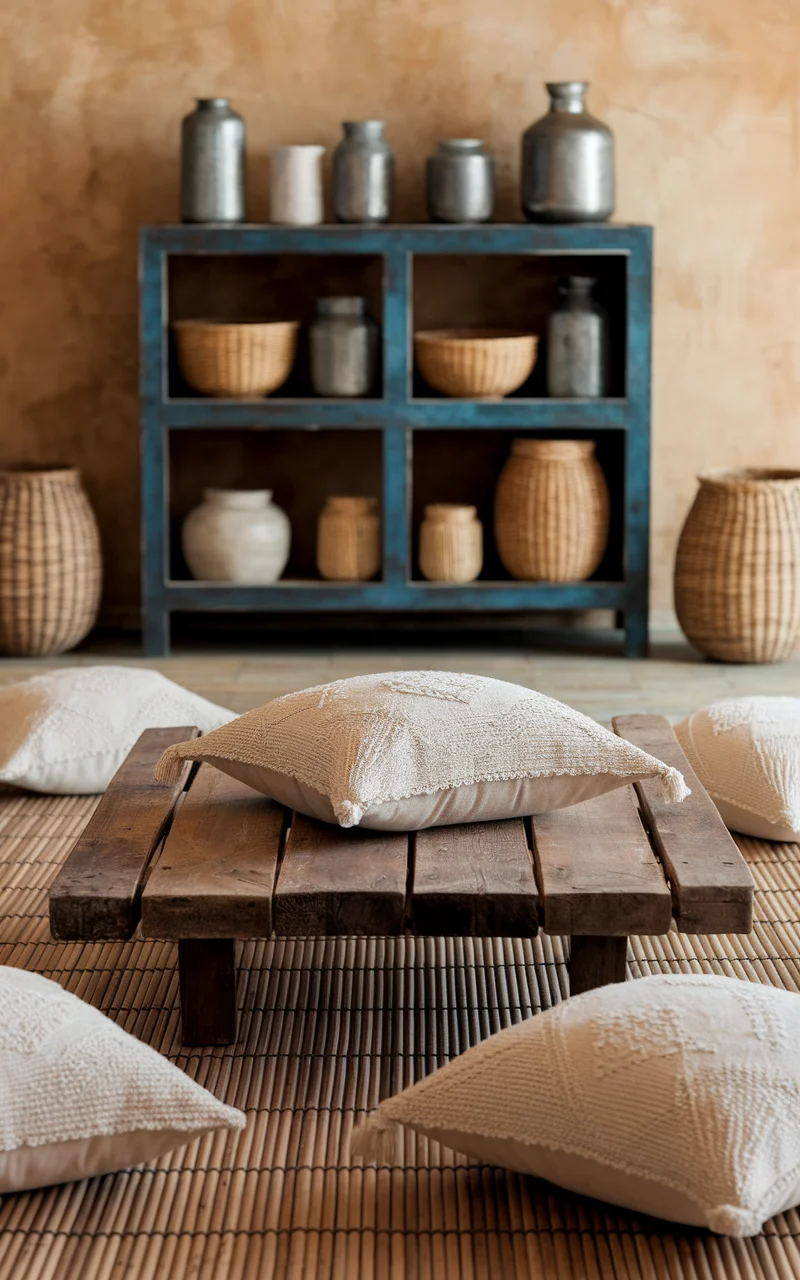
Introduce Zen-Inspired Flex Spaces
Incorporating Zen-inspired flex spaces within your Japandi home can boost its practicality and aesthetic appeal. This concept embraces versatility and calm, allowing spaces to serve multiple functions while maintaining a serene atmosphere. Zen principles highlight simplicity and mindfulness, creating areas that adapt to various activities without sacrificing tranquility.
How to Achieve It
Use Multi-Purpose Furniture
:
– Invest in furniture that serves more than one function, such as a fold-out desk/table or a daybed that doubles as lounge seating.
– Choose simple designs with natural materials like wood and neutral upholstery to ensure they complement the Japandi aesthetic.
Incorporate Sliding Doors or Screens
:
– Install shoji-inspired sliding doors or partitions to separate spaces without completely closing them off, enhancing flexibility and privacy.
– Opt for materials like wood and rice paper to introduce authentic Japanese elements while keeping the look light and airy.
Create Flexible Seating Arrangements
:
– Use floor cushions or poufs that can be easily moved around to accommodate different seating needs.
– Choose cushions made from natural fabrics like cotton or linen in earthy tones to blend seamlessly with the decor.
Integrate a Calm Color Palette
:
– Stick to soothing, neutral colors such as soft whites, beiges, and grays with hints of muted greens or blues to foster a calming environment.
– Use gentle accents in textiles or artwork to add subtle color interest without overwhelming the space.
Incorporate Modular Storage Solutions
:
– Utilize modular shelving units or stackable storage baskets that can be rearranged or relocated as needed.
– Opt for designs that use sustainable materials and have a sleek profile, maintaining the minimalist ethos.
By creating Zen-inspired flex spaces, you infuse your home with the adaptability of modern living while staying true to Japandi’s core values of simplicity and natural beauty. This approach not only enhances functionality but also ensures each area remains a peaceful retreat aligned with your lifestyle.
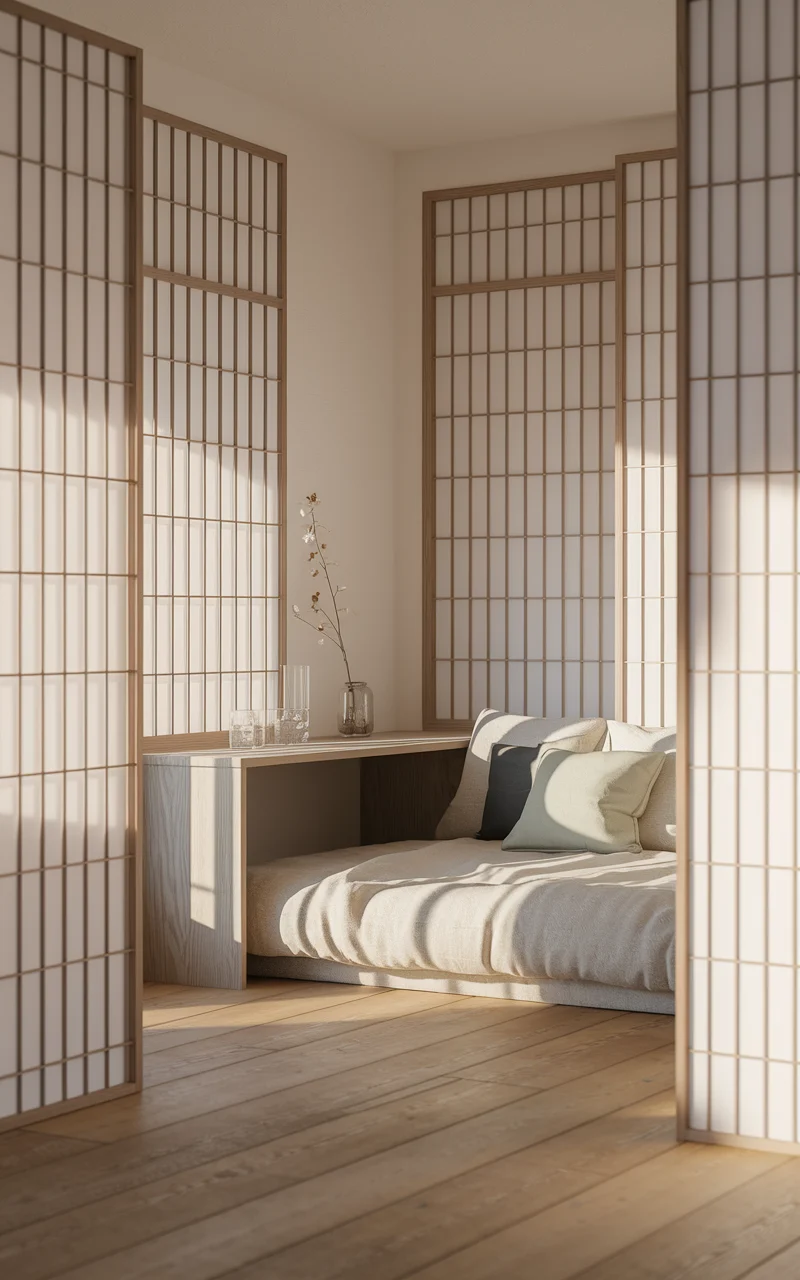
Embrace Wabi-Sabi with Imperfect Beauty
The Japandi style can be further enhanced by embracing the wabi-sabi philosophy, which stems from Japanese culture and cherishes the beauty of imperfection and transience. Incorporating elements that exhibit the grace of natural aging or craftsmanship irregularities adds character and warmth to a space, making it uniquely cozy and inviting. This viewpoint complements the minimalist and nature-inspired facets of Japandi design.
How to Achieve It
Select Handmade Ceramics
:
– Opt for handcrafted pottery and ceramics with slight imperfections, such as uneven surfaces or glaze variations.
– Use these pieces as vases, bowls, or decorative objects to showcase individual artistry and organic textures.
Feature Aged Wood
:
– Incorporate furniture or decor made from reclaimed or naturally aged wood, highlighting its unique grains and patina.
– Consider wooden items like a rustic dining table or an antique sideboard for their storied past and visual depth.
Incorporate Patinaed Metal
:
– Choose metal accessories with a patina or weathered finish, like bronze or copper, to add warmth and character.
– Use these elements in lighting fixtures or decorative accents to introduce rich, earthy hues and textures.
Embrace Textured Walls
:
– Apply plaster or limewash paint to walls for a naturally uneven, textured look that echoes traditional Japanese interiors.
– Opt for muted, earthy tones such as clay, taupe, or soft gray to enhance the cozy and soothing ambiance.
Display Artisan Textiles
:
– Integrate handwoven or naturally dyed textiles with subtle irregularities in color or weave patterns.
– Use these textiles as throws, cushion covers, or wall hangings to introduce warmth and visual interest through fabric.
By incorporating wabi-sabi elements, you can cultivate a Japandi space that celebrates natural beauty and individuality, creating a deeply personal and comforting environment. This concept helps ground the minimalist aesthetic in authenticity and emotion, inviting a serene appreciation for the passage of time and the stories held within each object.
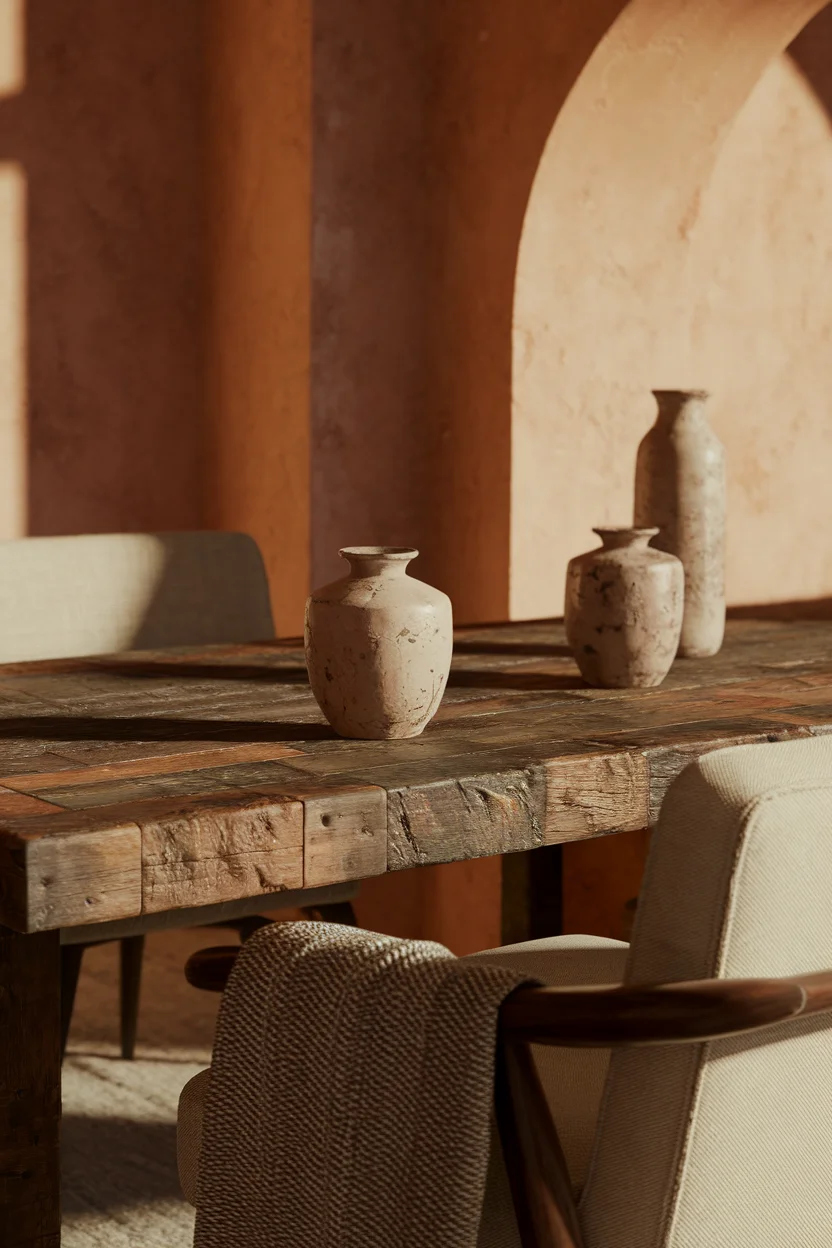
Curate a Tranquil Tea Nook
Creating a tranquil tea nook is a perfect way to embrace Japandi’s essence of simplicity, calm, and connection to nature. A quiet corner dedicated to tea rituals opens up a space for relaxation and mindfulness. This intimate area can become a personal retreat, embodying the harmony between Japanese tea traditions and Scandinavian coziness, making it a serene and inviting part of your home.
How to Achieve It
Select a Quiet Corner
:
– Choose a spot away from the main traffic areas of your home to ensure a peaceful atmosphere.
– Consider corners with natural light to enhance the calming environment.
Incorporate Low Seating
:
– Use floor cushions or a low wooden bench to create a traditionally inspired tea ceremony setting.
– Opt for cushions in natural fabrics like linen or cotton in muted colors such as dusty rose or soft green.
Use a Simple Tea Set
:
– Invest in a minimalist tea set with clean lines and a neutral palette, such as white or taupe.
– Choose handmade pottery or ceramic items to bring a touch of wabi-sabi and craftsmanship into the space.
Add a Small Table
:
– Choose a low table made of light wood like oak or pine to align with Japandi’s natural material focus.
– Ensure the table is large enough to hold your tea essentials but compact to maintain an uncluttered feel.
Integrate Natural Elements
:
– Incorporate a small plant or a vase with simple foliage to connect with nature.
– Use a woven mat or a hemp rug to add texture and warmth underfoot.
Maintain a Soft Color Palette
:
– Stick to soothing earth tones such as soft beige, cream, and warm gray.
– Add subtle accents, like blush tones or sage, to complement the natural surroundings without overpowering.
By establishing a tranquil tea nook, you create a reflective space within your home where you can savor quiet moments. This setup not only embodies the Japandi values of mindfulness and simplicity but also adds an element of ritual and relaxation to your daily life, fostering a cozy and inviting atmosphere.
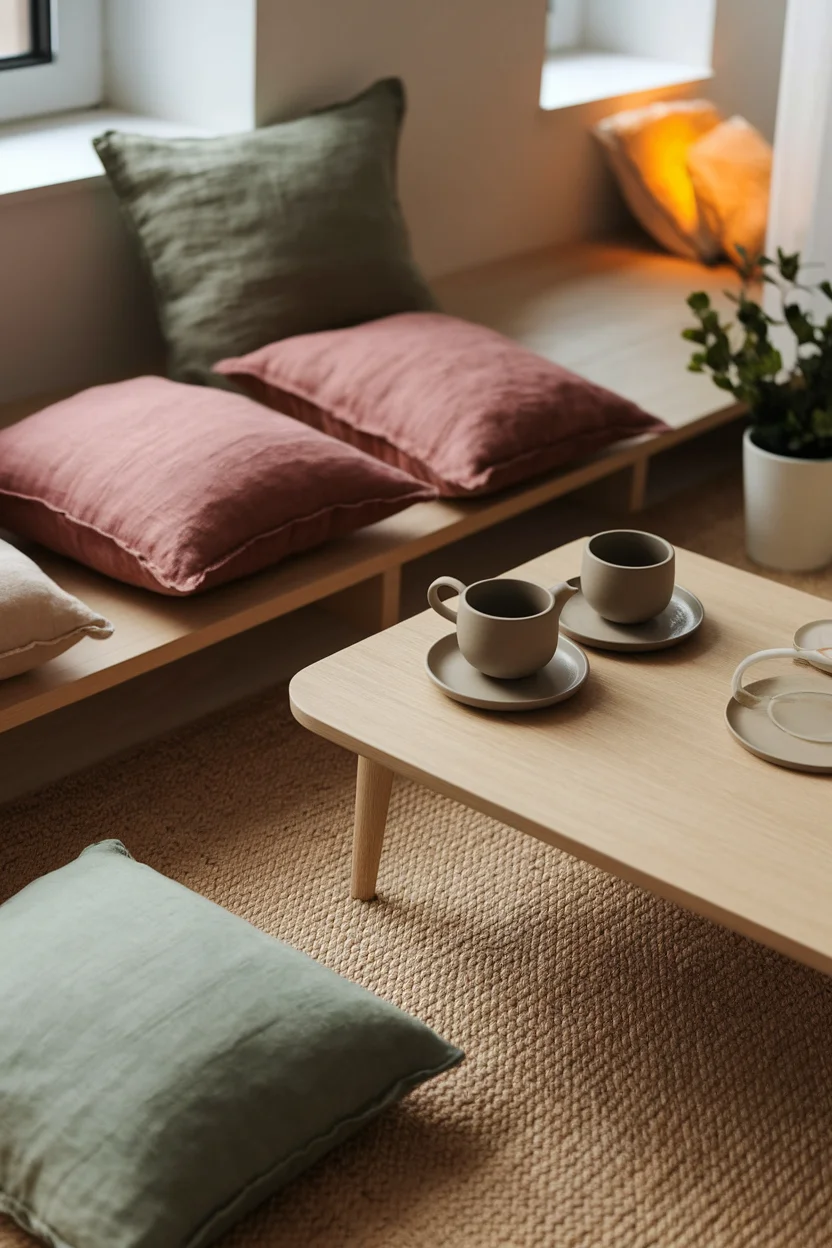
Incorporate a Zen-Inspired Meditation Zone
Crafting a dedicated meditation zone within your Japandi-styled home can enhance your space’s atmosphere of calm and balance. This area focuses on mindfulness and serenity, incorporating elements that promote tranquility and introspection. By infusing this dedicated space with principles of both Japanese minimalism and Scandinavian warmth, you can create a cozy yet uncluttered retreat ideal for relaxation and meditation.
How to Achieve It
Select a Quiet Location
:
– Choose a serene spot in your home, away from high-traffic areas, to minimize distractions.
– Opt for a space with natural light to enhance a peaceful, soothing ambiance.
Incorporate Natural Mats and Cushions
:
– Use a natural fiber mat, like a woven seagrass or jute mat, as the foundation for your meditation space.
– Opt for comfortable meditation cushions or floor pillows made from materials like cotton or linen in neutral, calming tones such as soft gray or muted beige.
Introduce Calming Scents
:
– Utilize a small diffuser or a selection of natural incense sticks with scents like lavender, sandalwood, or cedar to cultivate tranquility.
– Ensure your scent choice reflects both Japanese and Scandinavian preferences for subtle, natural fragrances.
Add Minimalist Decor
:
– Keep decor minimal and purposeful, such as a small zen garden or a simple stone sculpture, to foster focus and serenity.
– Incorporate elements like a single piece of natural art or a small water feature to encourage mindfulness.
Integrate Soft Lighting
:
– Use soft, ambient lighting such as a paper lantern or a low-wattage lamp to create a warm, inviting glow.
– Opt for lighting fixtures with clean lines and natural materials that echo the Japandi aesthetic.
Embrace a Neutral Color Palette
:
– Choose earthy tones like taupe, soft white, and gentle greens to maintain a harmonious and relaxed vibe.
– Introduce subtle splashes of color through natural elements like plants or a textile overlay for visual interest.
By integrating a Zen-inspired meditation zone within your home, you foster a sense of calm and mindfulness that aligns with Japandi’s core principles. This space serves as a personal sanctuary, promoting mental clarity and relaxation while maintaining a cozy and aesthetically pleasing environment.

Incorporate Natural Stone Elements
Introducing natural stone elements into a Japandi-inspired space enhances its organic appeal while maintaining the minimalist and warm essence of the style. Stone accents add an earthy, timeless quality to the environment, promoting a sense of stability and tranquility. By carefully selecting stone features, you can elevate your space with understated sophistication and a connection to nature.
How to Achieve It
Choose Stone Fixtures
:
– Integrate stone pieces, such as a marble or granite countertop, in your kitchen or bathroom for a sleek, durable surface.
– Opt for stone washbasins or sinks to introduce a unique, natural texture and focal point.
Introduce Stone-Accent Decor
:
– Incorporate stone vases or bowls as decorative elements to add subtle sophistication and earthiness.
– Use stone sculptures or bookends to introduce interesting forms and finishes without cluttering the space.
Consider Stone-Finishing on Walls
:
– Use stone veneer or cladding for feature walls to create visual interest and add depth to the room.
– Choose light-colored stones like limestone or travertine to maintain a bright and airy atmosphere while ensuring that the stone complements the overall Japandi color palette.
Utilize Stone Trays and Coasters
:
– Include small stone trays on tables or countertops to organize items while adding a textural element.
– Select stone coasters for a practical and stylish addition to your dining or coffee tables, emphasizing the natural theme.
Maintain a Harmonious Color Palette
:
– Stick to natural shades such as soft grays, beiges, and muted greens that complement the stone elements.
– Allow the stone’s natural tones to serve as a gentle contrast within your muted color scheme, enhancing the cozy, tranquil environment.
Adding natural stone elements aligns with the Japandi emphasis on organic materials and minimalist design, offering a serene, anchored feel to your space. This approach not only enhances the visual texture and sophistication of your environment but also strengthens the connection to nature inherent in Japandi interiors.

Integrate Tatami Mats for Texture and Warmth
Embrace the traditional Japanese method of integrating tatami mats to enhance the texture and warmth of your Japandi space. These mats, traditionally made of rice straw and woven with igusa grass, offer a touch of authenticity while providing a natural, cozy layer underfoot. Incorporating tatami mats can ground your space, offering both functional and aesthetic benefits that align with the Japandi ethos of simplicity and natural beauty.
How to Achieve It
Choose the Right Size and Placement
:
– Measure your room to determine the appropriate size and number of tatami mats needed.
– Use tatami mats to cover the entire floor or create specific zones within a larger space, such as a reading nook or meditation area.
Layer with Additional Textiles
:
– Add soft wool or cotton throws on top of the tatami mats to introduce warmth and texture.
– Consider layering with a neutral-toned area rug to enhance comfort and style, particularly in living spaces.
Maintain Compatibility with Furniture
:
– Choose low-profile furniture that complements the traditional feel of tatami mats, such as a low wooden table or floor cushions.
– Ensure furniture legs have protective pads to prevent damage to the mat???s surface.
Implement a Neutral Color Scheme
:
– Opt for a color palette that harmonizes with the natural tan and green hues of the tatami, such as soft whites, beige, and muted browns.
– Introduce subtle accent colors like sage or dusty mauve for added interest without overpowering the serene environment.
Integrating tatami mats not only enhances the cozy and natural ambiance of your Japandi space but also adds a rich cultural element. Their tactile quality and minimalist design perfectly align with the Japandi philosophy, creating a grounded and harmonious interior that invites relaxation and contemplation.
